Burning Man 2004
Tom Davis
Return to Tom Davis' home page.
Note: You can click on any of the images on this page to obtain a larger version.
Also: The first part is about the people we camped with, so it's probably only of interest to them. Further down the page are photos and descriptions of the art, which are probably more interesting to the general public.
Last Modified September 12, 2004.
What is Burning Man?
There's lots of text here, so just skip down the page if what you're interested in is images.
This page assumes that you know a bit about Burning Man. If you don't, I wrote a nice introduction in the web page that describes my first visit to Burning Man 2002.
Here is a page of photos from Burning Man 2003, and finally, for a description of some fairly toxic interpersonal relationships that occurred in 2003 and for a more complete description of the Desert Nose, see text description of Burning Man 2003, where a couple of names have been changed to protect the most guilty.
Camp Members
In addition to me and Ellyn, our camp consisted of Howard, the designer of the Desert Nose and the leader of the camp and his girlfriend, Franziska. In addition, from the previous year (or years) were Jesus (later joined by his girlfriend Sylvia), Impact Girl, and Racer. This year Racer was joined by his partner, Sparrow.
The camp also included Chris (a friend of me and Ellyn who had camped with us the previous year, but who had been to Burning Man more times than we had), another friend, Greg, who was a Burning Man virgin, and a gal whom I met via internet named BabeSoDelicious (Babe, for short), who was also a Burning Man virgin. Finally, Howard's friend Jon also was part of the camp, bringing the grand total to 13. Very late in the trip James, Chris' friend, arrived, and he camped with us for a couple of days since we did have room for him.
Chris, in addition to helping with the nose, had his own major art project which was displayed at night in our camp. It's called the MEZ and provides real-time impressionist video. Dancers in front of it can see themselves as they dance but distorted in various interesting digital ways.
Jesus had an interesting sport that, luckily, didn't kill him: he had a sort of long, retractable dog-leash with a huge magnet on the end of it. He put on roller-blades with huge wheels (perhaps 4 inches in diameter) that could be used on the playa, and then he'd hook the magnet to various art cars for a ride. The other interesting thing about having him in camp was that I got to say, "Thank you, Jesus" more times than I probably have during the rest of my life.
Sparrow did tons of cooking for the rest of us, mostly meat, and would give most of it away. In fact, most of the meals there were completely communal: everyone brought out food and everyone just ate anything that was available. It worked very well, and gave all of us much more variety than we'd expected.
One other interesting thing about Sparrow is that he seemed to know a lot about the old carneys. Maybe he had worked in one. And for future reference on this web page, according to Sparrow and to the the web page Welcome To The Fair, the term "talker" is correct for a person who lures people in to see attractions. Their definition of "talker" is: "TALKER - Never "barker." The man who makes the "outside openings" and "talks" in front of an attraction. If he talks inside the attraction, he is a 'lecturer'."
Preparations for 2004
This year my wife Ellyn and I decided to camp with the Nose Fish theme camp at Burning Man. The Desert Nose itself is described here. It was called "Nose Fish" since the original plan was to have the camp support both the Desert Nose and the Fishmobile. The Fishmobile, unfortunately, died just before we took off for the playa.
It is a theme camp, meaning that we were to provide and support a major piece of art at Burning Man. There were to be approximately 12 people in our camp to share the effort of setting up, taking down, and running the Desert Nose for the week of the event. The Desert Nose is a fairly major undertaking, so we knew that we'd all have to work pretty hard.
Since this was to be our third year at Burning Man, we already knew what to expect, owned most of the necessary equipment, and had lists of food, et cetera. The main changes we made to our personal preparations were to simplify the food even more. We wanted to avoid having to do any washing of dishes at all, and we pretty much succeeded.
Preparations for the Desert Nose, however, were not so simple. We participated in three "dome building parties": one to build our own dome, and two others to build domes for Racer and Sparrow and to build a community dome to be used by all of us on the playa. In addition to that, there was a general work day where we readied the stuff necessary for the general camp. This involved a lot of different things done by different people ranging from simply organizing stuff to constructing new things. The stairs to the camp's shower, for example, had been burned the year before, so building a new set was one of my projects.
Howard, Jesus, Racer and Sparrow were to drive Howard's truck, the "Fishmobile" to Burning Man early, beginning on Wednesday morning. It's a big, slow, overloaded truck, so they planned to get as far as Reno or so, spend the night, and then arrive at Burning Man very early the next morning. But on Tuesday, the Fishmobile broke down, so there was an emergency unloading/loading party to get the thousands of pounds of equipment from the Fishmobile to a rental truck. We got it done, and the four of them left on time on Wednesday.
Chris and I drove up beginning on Thursday morning in my van, and we arranged to meet Babe along the way and caravan with her. We got to the playa at about 5:00 pm without major incident where we met Howard et al. Howard, however, had not been so lucky. There was rain the night before and to keep them from destroying the road, all vehicles had to wait for 10-12 hours. Howard was very unlucky in that he'd managed to make it off the paved road for a mile or so and to the gate, but due to the rain, he couldn't go forward or back, and just had to wait. Had they been on the paved road, they could have gone to some small town and waited. As it was, they spent about 12 hours waiting and getting little sleep.
But once we were all there, we made pretty good progress setting things up -- first our personal tents, domes, et cetera, and then we started setting up the Desert Nose. Greg, Ellyn, Franziska and Impact Girl arrived on Saturday, and the nose was up and running by Monday when the event officially opened.
A bunch of us experimented this year with dry ice, since many of us arrived as early as Thursday and ice sales did not begin until Sunday or Monday. We rigged one cooler with frozen stuff and added chunks of dry ice to keep it really cold. It did work well, except when Chris attempted (and succeeded) in freezing some fruit (grapes and plums, I think). The fruit was, of course, frozen solid, and tasted OK if you ate it frozen, but when it thawed, it was really bad, and started to spoil very rapidly. Finally, we just put them out on a plate to dry in the sun, and it looked like an alien's entrails cooking. Pretty bizarre and disgusting, in a fascinating sort of way.
Desert Nose
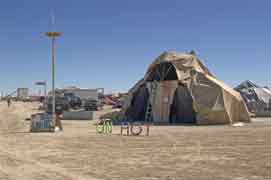 The Desert Nose is a structure modeled loosely after the geodesic dome invented by Buckminster Fuller, and designed to look like the nose of Buckminster Fuller himself. It was created by Howard, and in 2004 made its fourth appearance at Burning Man in the Nevada desert. Here is Howard's official page on the Desert Nose.
The Desert Nose is a structure modeled loosely after the geodesic dome invented by Buckminster Fuller, and designed to look like the nose of Buckminster Fuller himself. It was created by Howard, and in 2004 made its fourth appearance at Burning Man in the Nevada desert. Here is Howard's official page on the Desert Nose.
The nose is constructed of around 300 steel struts, bolted together at their ends, and covered by tarps. It took two days to set up. Except for the fact that each strut on the left has a matching strut on the right, all of the struts have different lengths, so it is a bit of a mess to set up.
The complete nose is shown in the illustration to the left. The nostrils are visible, and serve as the entrance. As visitors enter, of course, they have to work their way through the "nose hairs" that hang in the nostrils and help keep out dust, as do the nose hairs in normal noses.
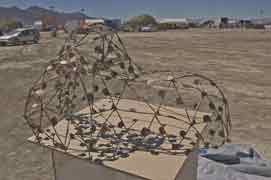
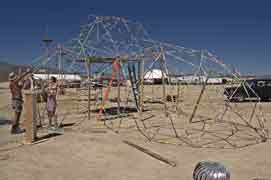 On the left is a photo of the model Howard constructed to help with the nose construction. Each strut in the model is numbered and each end is colored to match the colors on the true struts. This is a model of the left half of the nose, since the right side is symmetric. The nose skeleton appears on the right, where you can see Racer and Impact Girl tightening the bolts with an impact wrench.
On the left is a photo of the model Howard constructed to help with the nose construction. Each strut in the model is numbered and each end is colored to match the colors on the true struts. This is a model of the left half of the nose, since the right side is symmetric. The nose skeleton appears on the right, where you can see Racer and Impact Girl tightening the bolts with an impact wrench.
To aid in the construction, each strut is numbered as it is in the model, and at each vertex, all the struts meeting at that vertex have the same color code. The first color indicates the general region of the nose, the second indicates (roughly) the rank, or height above the ground, and the third differentiates among nose struts with the same region and rank. If you look closely at the image on the right, you can see that all the struts meeting at each point share the same color scheme. Thus an easy visual check allowed us to find a lot of errors before they occurred. In the image below and to the right, you can see Racer and Impact girl tightening one bolt together with a close-up view of one of the vertices, where all the colors match.
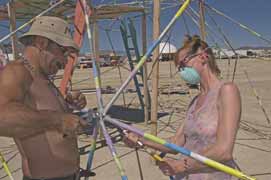 When the nose is operational, visitors enter through the nostrils ("Pick either nostril!") and stand on a carpet in front of a big fan where they are sprayed with a mist of water, providing instant cooling. During the hottest part of the day, it can feel wonderful, and give the recipient what Howard loved to call a "coolgasm".
When the nose is operational, visitors enter through the nostrils ("Pick either nostril!") and stand on a carpet in front of a big fan where they are sprayed with a mist of water, providing instant cooling. During the hottest part of the day, it can feel wonderful, and give the recipient what Howard loved to call a "coolgasm".
Of course not too many people will just walk into a black hole in some weirdly distorted dome that may or may not look like a nose to the casual observer, even at Burning Man, so we had to bark them in (or talk them in). This was sort of fun, and I really got into it. Initially, I sat on the deck of of nose, over the nostrils, and called out to people in the plaza, but soon I decided that it would work much better to be on the ground and to go right up to them and try to talk them in. It seemed to work a lot better with full eye-contact, and when I could answer their questions, and I got to apply all those high-pressure sales techniques that have been practiced on me over the past many years:
"Hey! Are you too hot? Well, there's something you can do about it! Come into the Desert Nose where we have giant water misters to cool you down in just 20 seconds. Just 20 seconds of your valuable Burning Man time is all that it takes -- it's the best 20 seconds you can spend on the hot playa on a hot afternoon. Better than sex! Come in for a coolgasm! Look, it's not like you're going to be late for work! Experience the magic of evaporative cooling. Oh, and the physics, too." (And then, if there was the slightest hesitation,) "Good choice!!! Pick either nostril!"
What was interesting is that after doing this for an hour or so, in all its myriad variations, I began to be unable to understand it. The whole spiel became meaningless, but I found I could easily maintain grammatical correctness, even though I was incapable of understanding the semantical part of the talk. Very interesting!
One thing that Howard did particualarly well was to run a "zero-impact" camp. Our goal was to leave the playa exactly as we had found it, and this included not only not leaving any trash, but even carrying out our gray water. We recycled everything possible, and in general, did quite a good job.
It was so good, in fact, that Howard recieved an "LNT" award from the "Earth Guardians" camp. "LNT" stands for "Leave No Trace". What struck me as particularly weird is that when he got the award, the guardians presented him with all sorts of junk proclaiming the quality of the camp. But all this junk (certificates, decals, signs, et cetera) was exactly the kind of thing that you don't want to leave around, and in the heavy winds, we almost lost some of the signs which was the exact opposite of what the guardians wanted to promote. Oh well ...
Über Carney
One of the most entertaining events at Burning Man 2004 occurred at the Über Carney whose central attraction was a bizarre sort of roller-coaster. Sorry, that's "roaster-coaster", due to the fire it directed at the riders. It had a single car that rode on a track shaped somewhat like the letter U. Two victims are strapped into the car, and it is hauled by a winch to the top of the U, where it hangs for a few moments and then is dropped straight down. It then oscillates up and down the two sides until it comes to a stop at the bottom.
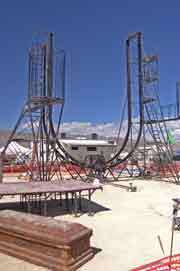 In the image on the right, you can see the roaster-coaster, together with one of the go-go cages, the coffin in front, and the car, sitting at the bottom of the U. The Über carney, of course, only ran late at night so that the jets of fire would be more effective.
In the image on the right, you can see the roaster-coaster, together with one of the go-go cages, the coffin in front, and the car, sitting at the bottom of the U. The Über carney, of course, only ran late at night so that the jets of fire would be more effective.
What makes it a wild ride is that the car can spin on an axis, and does so repeatedly, in both directions. I was always surprised not to see a stream of vomit ejected from it as it spun.
But it took a couple of minutes to unstrap one set of victims and to strap in another, so the folks in the Über Carney camp arranged other diversions; namely, a couple of cages for go-go dancers and a great barker (or maybe "talker", if Sparrow is right).
The talker made it clear that as opposed to "real" carneys where the goal is to amuse the visitors, the Über Carney was to amuse the camp. If, by some amazing chance, the visitors were amused, that was just a lucky side-effect. He explained how the designer of the roaster-coaster was very proud of the fact that this was the first one he'd ever designed, that he'd learned that bad welds could be covered with duct tape, and that for the last 10 minutes, there hadn't been a single death.
He told us that he knew that probably many of us had roller-coasters salvaged from carnivals in our backyards, and that when we'd tried to put them together, we probably had almost as many left-over parts as they did at the Über Carney. As the winch hauled the car to the top of the U to be dropped, it would often jam, and a camp member would clobber the winch with a sledge hammer to loosen it. Finally, as the car dropped and spun, blasts of propane-fueled fire just missed it, hitting just above or below the spinning car. They did have a coffin nearby to accommodate the next fatality.
And during all this, the go-go girls ground out their routines, which were quite impressive, considering that the go-go girls were also volunteers from the crowd. In fact, the go-go girls were so riveting that there was almost no laughter from the crowd at the hilarious monologue from the talker.
The first time we visited the Über Carney, there was a long line of people waiting to ride. The second night, they'd solved the problem; there was no line, but the talker merely spun a wheel and the result of the spin determined who the next riders were. Sometimes the wheel would demand a body piercing, sometimes a tattoo, sometimes the dirtiest hair, and so on. But there was always somebody crazy enough to get on.
Finally, there were a set of "rules" posted in front of the roller-coaster. They included such things as: Please wait in line without making "moo" noises. Do NOT ride this attraction if you are being audited by the IRS, are incontinent, are currently channeling Elvis, or are hooked on phonics.
Art
The Diver
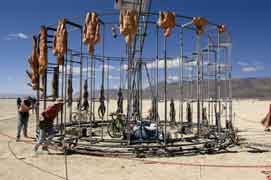 The same artist who created "The Swimmers" a couple of years ago had a similar sculpture this year called "The Divers". As the carousel turned, a strobe light flashed as each of the models moved past.
The same artist who created "The Swimmers" a couple of years ago had a similar sculpture this year called "The Divers". As the carousel turned, a strobe light flashed as each of the models moved past.
It would have been beautiful with just that, but unfortunately, it was made too complicated. The artist wanted to have a burst of fire as the diver left the top and a splash of water as his hands hit the playa. So there were all sorts of extra things to get done, and time spent on those took away time that could have been spent making the minimal art piece work really well. In fact, in spite of the effort put in, the fire and water parts never worked.
The Swimmer was powered by a person turning the crank on a bicycle that turned the wheel upon which the swimmers sat. The divers were supposed to be powered by bicycles as well, but the structure was so heavy that it was impossible for one person to get it moving. Perhaps four people on the four provided bikes might have been able to do so, but requiring such a high amount of cooperation from Burners is asking too much.
So since that didn't work, the alternative plan was to use a motor scooter for power, and one was bolted in place of one of the bicycles. But the scooter still was unable to start the structure moving, although it could keep it moving once it was going. Humans pushing the structure were required. And after about a day of this, the tire on the scooter was destroyed. It seems like this most important part of the artwork -- making it move -- was not tested, probably due to time spent on frills, so the entire artwork was a sort of failure.
We were lucky enough to see it in operation, but that only occurred when there were enough people to get it moving by hand and someone from the artist's group was there to ride the scooter.
Chris had a good idea for how to make the artwork function during the day with a sort of zoetrope of which he built a prototype out of a bicycle wheel and a sheet of cardboard, but in spite of the fact that he made repeated appointments with the artist to show it off, the artist never made it to his appointments. Too bad.
Pinhole Camera
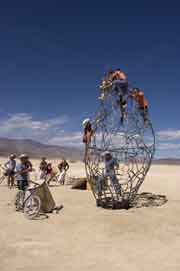
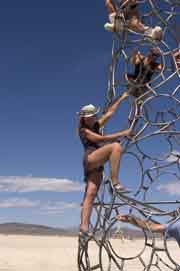 I was riding across the playa and met a bicycle hauling three cardboard barrels behind it in a sort of train. It didn't look particularly artistic, so I asked what it was. It turns out to have been three giant pinhole cameras, each loaded with a single piece of film that was about three feet by four feet. The hole was covered with tape, and after the camera was set up, the tape was removed, the film exposed for between one and four minutes (depending on how much sun there was), then the tape was replaced, the barrel returned to the Pinhole Camp, and the film developed. In the camp were posted a number of the better photos that had been taken in the previous few days. Since it was standard photo paper, the images were all "negatives".
I was riding across the playa and met a bicycle hauling three cardboard barrels behind it in a sort of train. It didn't look particularly artistic, so I asked what it was. It turns out to have been three giant pinhole cameras, each loaded with a single piece of film that was about three feet by four feet. The hole was covered with tape, and after the camera was set up, the tape was removed, the film exposed for between one and four minutes (depending on how much sun there was), then the tape was replaced, the barrel returned to the Pinhole Camp, and the film developed. In the camp were posted a number of the better photos that had been taken in the previous few days. Since it was standard photo paper, the images were all "negatives".
In the image on the right you can see the barrel in the lower left corner pointing at the jungle-gym type structure with people climbing on it. The exposure was for 55 seconds. Since all the models had to hold as still as possible for 55 seconds, I took the opportunity to snap a couple of regular photos, including the one on the right of a woman who's a member of the pinhole camp.
"Coneahedrons"
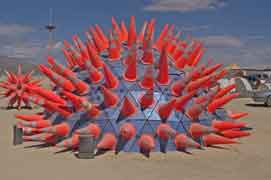 The camp right next to us contained a number of structures reminiscent of geodesic domes, but constructed with traffic cones. The image on the right shows two -- one large one centered, but with a complete one visible behind it and to the left.
The camp right next to us contained a number of structures reminiscent of geodesic domes, but constructed with traffic cones. The image on the right shows two -- one large one centered, but with a complete one visible behind it and to the left.
If you look closely at the structure of the larger art piece, you can see that if each edge of each triangular cone base were replaced with a strut, the result would be a standard geodesic dome. In this case, it would make a "4V" dome. The structure behind it is like a "2V" dome, but completed to an entire sphere.
To learn more about what the terms "2V" and "4V" mean, go to the Desert Domes web page.
By the way, the term "coneahedron" is my own invention; I have no idea what the artists called these structures.
Performance Art: Naked Men and French Maids
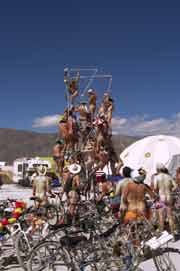
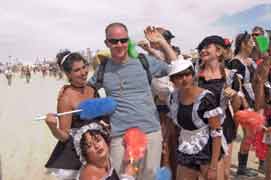 There was quite a bit of performance art at Burning Man, but often it required a bit of luck to be at the right place at the right time with a camera. Or I suppose you could read the schedules, but who has time to do that? In any case, here are a couple of scenes I did capture.
There was quite a bit of performance art at Burning Man, but often it required a bit of luck to be at the right place at the right time with a camera. Or I suppose you could read the schedules, but who has time to do that? In any case, here are a couple of scenes I did capture.
The first is the male response to Friday's "Critical Tits" bicycle ride where thousands of topless women ride a long route around the Esplanade, and eventually to a party. The men's bottomless version had many fewer participants, but it was clear that most of them were suffering from a severe case of testosterone poisoning when they stopped in front of a sort of dome-like structure and perhaps twenty of them decided to climb it at the same time. If they weighed 150 pounds each, then 20 x 150 = a ton and a half, which is a pretty big load to put on the bottom struts. I think something started to bend, since there was a sudden panic, and you never saw people climbing down so fast.
The other photo was a march organized for anyone in a french maid costume -- mostly women, but with a few men tossed in for good measure. As they marched down the playa, it wasn't too surprising that they found plenty of things to clean, given that the ground everywhere was covered with an inch or so of playa dust!
One thing I saw, but did not obtain a good photo of, was a woman in a serving maid's outfit, walking down the playa with a tray of crudités: carrots, broccoli bits, snap peas, et cetera, all very fresh, and she misted them regularly with water. She spoke a sort of fractured French, and got business from everyone.
Eyeballs on Bikes
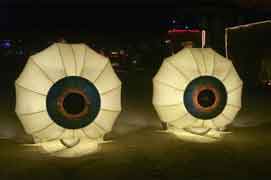 My award this year for the "best bang for the buck" goes to the eyeball bicycles, an image of which appears to the right. The eyeballs are beautiful, more-or-less anatomically correct, and they were well-lit from behind, so that at night there were two glowing eyeballs moving around on the playa. The fact that the bikes were never completely synchronized made the effect even better, I thought.
My award this year for the "best bang for the buck" goes to the eyeball bicycles, an image of which appears to the right. The eyeballs are beautiful, more-or-less anatomically correct, and they were well-lit from behind, so that at night there were two glowing eyeballs moving around on the playa. The fact that the bikes were never completely synchronized made the effect even better, I thought.
The only other art I saw that was nearly as elegant I did not, unfortunately, get a photo of. One night I saw it in the distance -- a rapidly moving man on a bicycle that looked like he was on fire. I couldn't figure out how the lighting was made so realistic until the next night when I happened to see him at close range, again, travelling rapidly. In fact, I was not seeing the rider at all -- he was in dark clothing on the front seat of a tandem bicycle. On the back seat was a metal man whose legs moved since they were attached to the pedals, but actual fire poured from holes in the metal. What I saw really was a man on fire! No wonder he was pedaling fast.
Well, as a bumper sticker I saw there said, "If you make a man a fire, he will be warm for a day, but if you set that man afire, he will be warm for the rest of his life."
There were lots of very interesting bikes there, and unfortunately, I did not get pictures of some of the best ones. In addition to the "usual" examples where the lengths of the tubes were very wrong, one guy had a bike where each wheel sat on top of another wheel, so he had to pedal backwards to make the wheel underneath go forward. Then there was a guy who took the idea one step farther, and had three wheels stacked, so he could pedal in the usual way.
There was a "sideways bike" where the rider reclined and pedaled as if he were on a recumbant bike, but the wheels were perpendicular to the normal direction, so he moved sideways. Finally, there was a guy who had a sort of crescent of wheels, each smaller than the last, and the largest of which rubbed against the rear wheel. The crescent rose over his head, with each wheel turning in a direction opposite to the wheel before it. These extra wheels were simply for art, whereas the stacked wheels mentioned in the previous paragraph were for propulsion.
Miscellaneous Art
Here are a bunch of photos without comment, as I really don't know any more about them than you do, but I liked both the art and the photo:
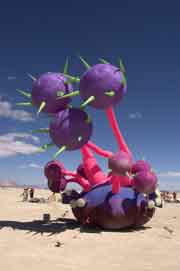
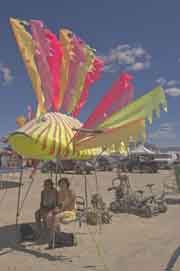
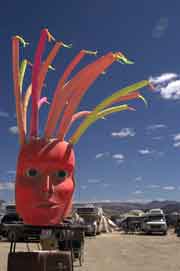
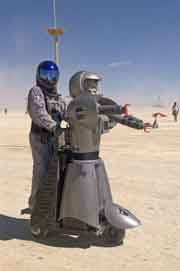
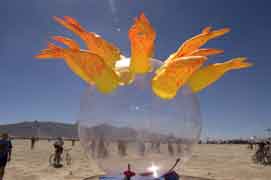
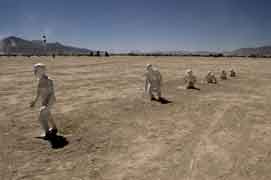
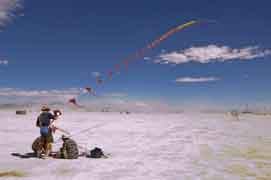
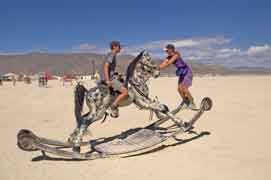

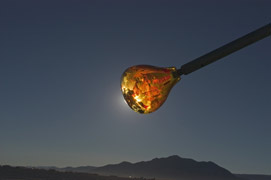
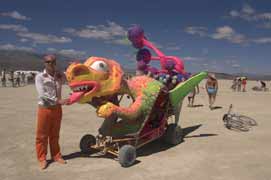
Early Man and The Burn
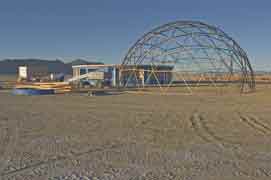
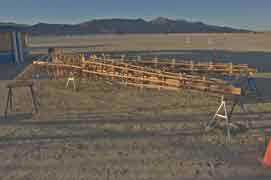 This year I had the very good fortune to arrive at Burning Man long before most people. The event officially opens at midnight between Sunday and Monday, but I was there on Thursday afternoon, before The Man was even set up.
This year I had the very good fortune to arrive at Burning Man long before most people. The event officially opens at midnight between Sunday and Monday, but I was there on Thursday afternoon, before The Man was even set up.
On the right is an image of the dome on which the man stood and the dome itself, before it was lifted by a crane to sit on top of the building. On the left is the man on the ground, headless, and without the neon lights yet attached. The dome on which the man stood is made of 2x4s, so that it would burn rapidly on Saturday night. Notice just how empty the playa was, this early in the week.
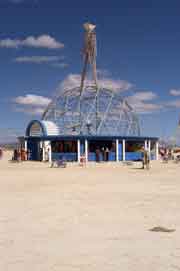
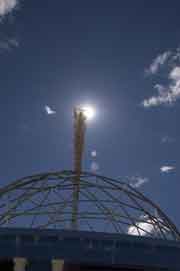 Here are a couple of photos of the man just after he was put together -- man atop dome atop building. Note that The Man's arms are down.
Here are a couple of photos of the man just after he was put together -- man atop dome atop building. Note that The Man's arms are down.
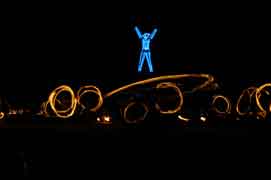
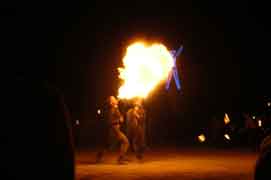 Before The Man burned, there was a large set of poi spinners (people who spin fire on short chains in artistic patterns) combined with other folks who play with fire in different ways, including some fire breathers. The images on the left and right show a couple of examples. The idea is to build the suspense before The Man himself is burned, and the whole thing takes about 20 minutes.
Before The Man burned, there was a large set of poi spinners (people who spin fire on short chains in artistic patterns) combined with other folks who play with fire in different ways, including some fire breathers. The images on the left and right show a couple of examples. The idea is to build the suspense before The Man himself is burned, and the whole thing takes about 20 minutes.
It seemed like a long time, but at least there was some action, as opposed to the burning of the "Temple of the Stars" the following night where we waited and waited and nothing happened for much more than 20 minutes.
The next series of shots were taken during the burn itself. The photos below are in temporal order, so as you move to the right and then down, the fire has progressed more and more until you can see the man falling down in the final shot. Notice that in the photos above, the man's arms are down, as they were all week long. But when it's time for the burn, the arms are raised, as they are in the intial photos below. Last year and the year before, mechanical failures caused the arms to drop even before the fire started, so this is the first year in at least three when we didn't burn a cripple.
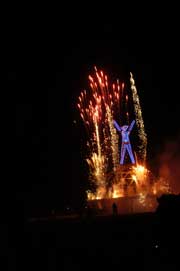
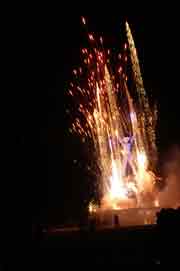
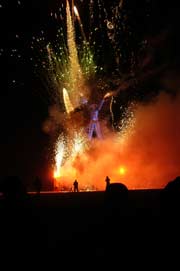
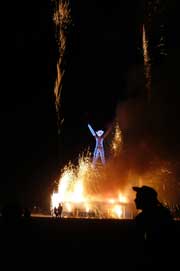
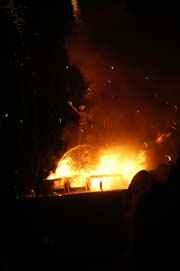
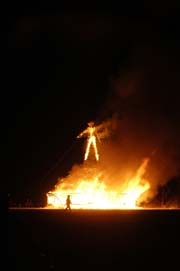
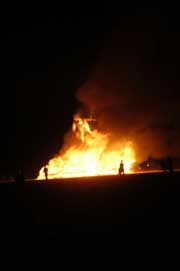
Additional Art
In this section I'll describe some other artworks I saw, but of which I have no photos, or at least no good photos.
Pseudo Three-Dimensional Surface
A couple of guys placed a bunch of sheets of plywood together on the playa and painted them with patterns of solid colors like red, green, yellow and blue, but with a black edge to each. Then the viewers donned special glasses whose lenses were fitted with diffraction gratings and we walked on the surface. Since the gratings behaved like mini-prisms, light of different colors was bent by different amounts, and red objects appeared higher than yellow objects and blue objects appeared to be below all of them. It was a weird feeling.
Chairway to Heaven
Near our camp was the "Chairway to Heaven". It was a tower with a seat mounted on it that you could get on, and then with proper counter-weights, you'd be lifted up perhaps 60 or 70 feet to obtain a grand view of the playa and Black Rock City. I asked the folks running it if people often lied about their weight (which was needed to make the counter-balance work) and they said that it happened all the time. Luckily, if you lie and say you're lighter than you really are, which was the usual "error", they don't put on enough counter-weights and you don't move. If there were too many counter-weights, it might be hard to get you down.
Fishing for Ravers
I only saw this once, at the "Hick House", where a bunch of people did improv theatre in front of a house that looked like it could have belonged to hillbillies from deepest West Virgina, but apparently it's commonly done at Burning Man. I was walking by and saw a glowing bracelet on the ground but as some guy bent over to pick it up, it suddenly jerked away. Then the "hicks" started laughing, since the
bracelet was tied to a fishing line and a pole. Apparently the ravers go for the bracelet bait more than for anything else -- even the little flashing lights.
Ping-Pong Art
One quite impressive installation was a cube perhaps eight feet on a side that was filled with a grid of ping-pong balls suspended on strings in a regular way. Inside the cube were nine rows of nine columns of strings with nine balls on each for a total of 729 ping-pong balls. Each ball contained a red, green and blue LED, and the whole mess was controlled by a PC.
It made pretty amazing patterns, but it represented a hell of a lot of work. What was even more amazing, in a way, was the fact that the PC that was controlling it was sitting on the playa with no protection. The fans would blow playa dust directly into the guts. What's amazing is that it still seemed to work!
Heading Home
After The Man burns, there's a huge party all over the playa, but we managed to get to sleep by 1:30 am or so. We got up early on Sunday and worked like crazy to take down the dome, pack all our stuff, and so on. Howard's plan was to leave early on Monday morning, but Chris' and my plan was to leave late Sunday, after the burning of the Temple of the Stars. Ellyn and Greg left at about noon, on Sunday, as was their plan.
We got pretty much everything packed by Sunday night at 8:00, went to the burning of the Temple of the Stars, and returned with the van packed and ready to go. Chris and I drove all night, and I arrived home at about 6:30 am on Monday.
Only later did I hear about the troubles Howard's crew had. Due to various circumstances, they didn't get going until about noon on Monday, and they got on the road at about the same time as 10,000 other burners were trying to leave the playa. It had taken Chris and me perhaps 10 or 15 minutes to make it from our camp to the paved road, but with 10,000 other people trying to do the same, it took Howard three hours. When I finally met him for the unloading of the truck, he was totally exhausted.
Want to send me mail? Click here: tomrdavis@earthlink.net.
Return to my home page.

 On the left is a photo of the model Howard constructed to help with the nose construction. Each strut in the model is numbered and each end is colored to match the colors on the true struts. This is a model of the left half of the nose, since the right side is symmetric. The nose skeleton appears on the right, where you can see Racer and Impact Girl tightening the bolts with an impact wrench.
On the left is a photo of the model Howard constructed to help with the nose construction. Each strut in the model is numbered and each end is colored to match the colors on the true struts. This is a model of the left half of the nose, since the right side is symmetric. The nose skeleton appears on the right, where you can see Racer and Impact Girl tightening the bolts with an impact wrench.
 The Desert Nose is a structure modeled loosely after the geodesic dome invented by Buckminster Fuller, and designed to look like the nose of Buckminster Fuller himself. It was created by Howard, and in 2004 made its fourth appearance at Burning Man in the Nevada desert. Here is Howard's official page on the Desert Nose.
The Desert Nose is a structure modeled loosely after the geodesic dome invented by Buckminster Fuller, and designed to look like the nose of Buckminster Fuller himself. It was created by Howard, and in 2004 made its fourth appearance at Burning Man in the Nevada desert. Here is Howard's official page on the Desert Nose.


 The same artist who created "The Swimmers" a couple of years ago had a similar sculpture this year called "The Divers". As the carousel turned, a strobe light flashed as each of the models moved past.
The same artist who created "The Swimmers" a couple of years ago had a similar sculpture this year called "The Divers". As the carousel turned, a strobe light flashed as each of the models moved past.

 I was riding across the playa and met a bicycle hauling three cardboard barrels behind it in a sort of train. It didn't look particularly artistic, so I asked what it was. It turns out to have been three giant pinhole cameras, each loaded with a single piece of film that was about three feet by four feet. The hole was covered with tape, and after the camera was set up, the tape was removed, the film exposed for between one and four minutes (depending on how much sun there was), then the tape was replaced, the barrel returned to the Pinhole Camp, and the film developed. In the camp were posted a number of the better photos that had been taken in the previous few days. Since it was standard photo paper, the images were all "negatives".
I was riding across the playa and met a bicycle hauling three cardboard barrels behind it in a sort of train. It didn't look particularly artistic, so I asked what it was. It turns out to have been three giant pinhole cameras, each loaded with a single piece of film that was about three feet by four feet. The hole was covered with tape, and after the camera was set up, the tape was removed, the film exposed for between one and four minutes (depending on how much sun there was), then the tape was replaced, the barrel returned to the Pinhole Camp, and the film developed. In the camp were posted a number of the better photos that had been taken in the previous few days. Since it was standard photo paper, the images were all "negatives".
 The camp right next to us contained a number of structures reminiscent of geodesic domes, but constructed with traffic cones. The image on the right shows two -- one large one centered, but with a complete one visible behind it and to the left.
The camp right next to us contained a number of structures reminiscent of geodesic domes, but constructed with traffic cones. The image on the right shows two -- one large one centered, but with a complete one visible behind it and to the left.

 There was quite a bit of performance art at Burning Man, but often it required a bit of luck to be at the right place at the right time with a camera. Or I suppose you could read the schedules, but who has time to do that? In any case, here are a couple of scenes I did capture.
There was quite a bit of performance art at Burning Man, but often it required a bit of luck to be at the right place at the right time with a camera. Or I suppose you could read the schedules, but who has time to do that? In any case, here are a couple of scenes I did capture.
 My award this year for the "best bang for the buck" goes to the eyeball bicycles, an image of which appears to the right. The eyeballs are beautiful, more-or-less anatomically correct, and they were well-lit from behind, so that at night there were two glowing eyeballs moving around on the playa. The fact that the bikes were never completely synchronized made the effect even better, I thought.
My award this year for the "best bang for the buck" goes to the eyeball bicycles, an image of which appears to the right. The eyeballs are beautiful, more-or-less anatomically correct, and they were well-lit from behind, so that at night there were two glowing eyeballs moving around on the playa. The fact that the bikes were never completely synchronized made the effect even better, I thought.












 This year I had the very good fortune to arrive at Burning Man long before most people. The event officially opens at midnight between Sunday and Monday, but I was there on Thursday afternoon, before The Man was even set up.
This year I had the very good fortune to arrive at Burning Man long before most people. The event officially opens at midnight between Sunday and Monday, but I was there on Thursday afternoon, before The Man was even set up.










